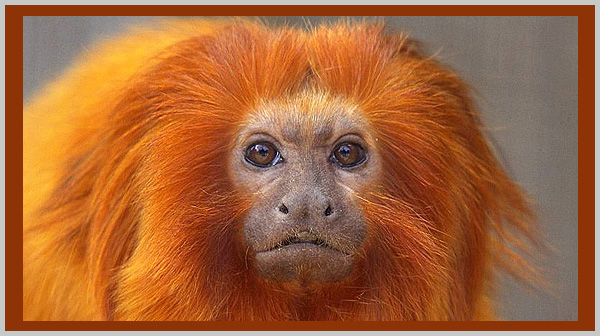
Golden Lion Tamarin
Name: Golden Lion Tamarin (Leontopithecus rosalia)
Conservation Status: Endangered (2021 IUCN Red List)
Wild Population Estimate: 3,700
Range: Brazil
Threats: Development / Transportation / Agriculture / Pet Trade
Tiny, agile, and highly social, the golden lion tamarin has captivated people the world over. The tamarin has become a flagship species, highlighting the demise of its Tropical rain forest home. The golden lion tamarin’s long, silky fur, particularly at the shoulders, gives it a lionlike mane. Tamarins are some of the smallest members of the primate family. They are only 8 to 14 inches (20-36 cm) long (not including tail) and weigh less than 2 pounds (900 g).
Species Range and History
Large rivers, barren lands, and croplands are insurmountable barriers to these tiny monkeys. Isolated by these barriers, many different types of tamarins and marmosets have evolved in close proximity in the tropical rain forests of South America.
The golden lion tamarin’s historical distribution is not well known. Today, it is confined to three small areas of tropical rain forest in southeastern Brazil. The first population estimate of 400 to 500 animals was made in 1972. The population estimate was reduced to fewer than 200 by 1981. More recent surveys (IUCN Red List 2021), suggest there may be as many as 3,700 golden lion tamarins left in the wild.
Natural History
These tiny monkeys are quick-moving, acrobatic, and analytical masters of their arboreal world. Tamarins have sharp, curved claws on their toes for gripping tree trunks and branches. Most other monkeys have flat nails more like human finger nails.
Tamarins are diurnal (active during the day), feeding on insects, small vertebrates, and fruit. Tamarins have very specific habitat requirements; they occupy dense, low-elevation tropical rain forest. They live in territorial family units of up to 15 individuals. Groups usually are composed of one breeding pair and their offspring or other close relatives.
Causes of Endangerment
Habitat Loss and Overexploitation
The coastal tropical rain forests of Brazil where the golden lion tamarins live is also the region preferentially settled and cleared for agriculture and ranching. These areas are most pressured by today’s growing human population.
In addition to habitat destruction, golden lion tamarins were hunted for food and captured for the pet trade, display in zoos, and biomedical research. Tamarins also were persecuted by local people who mistakenly believed that they carried yellow fever and malaria.
Conservation Actions
Habitat Protection and Community Education
Most of the area where tamarins occur in the wild was declared a preserve in 1980, but it is poorly protected. CITES prohibits trade, and local laws prohibit killing of the species. However, a recent study showed that the Brazilian community-education program on the endangered golden lion tamarin was failing to reach local farmers.
Although the tamarin is widely used as a symbol and focal point to encourage conservation of endangered coastal rain forest, only 19 percent of farmers approached knew the tamarin was endangered.
Captive Breeding and Reintroduction
An intensive reintroduction program has allowed more than 70 tamarins to be released into Brazil’s protected area. Mortality is high; however, up to 70 percent die in the first year after release When zoo-born tamarins are set free in the forest they become disoriented and helpless and do not know how to feed themselves.
Efforts are being made to release golden lion tamarins into “half-way houses,” large caged-in areas of the rain forest, where the tamarins can learn to navigate their multidimensional habitat while being protected from predators and supplied with food supplements.
It is unknown if zoo-born golden lion tamarins can be taught to survive in their native forests. Conservationists hope that the first generation of wild-born babies will be better able to survive.
Questions for Thought
How does the social structure and breeding behavior of the golden lion tamarin present a challenge to reintroduction efforts?
What more could be done to help the local people, particularly farmers, recognize the value of saving golden lion tamarins?
Explore:
Related Classroom Activities:
[CS1-1,CS1-3,CS2-5, General]
Click here for Endangered Species Classroom Glossary